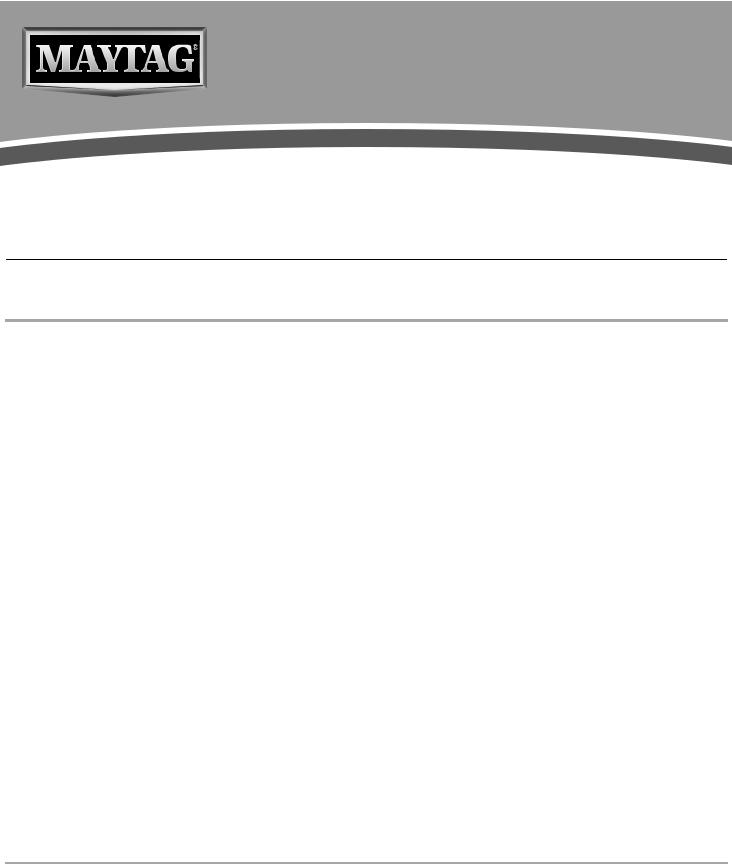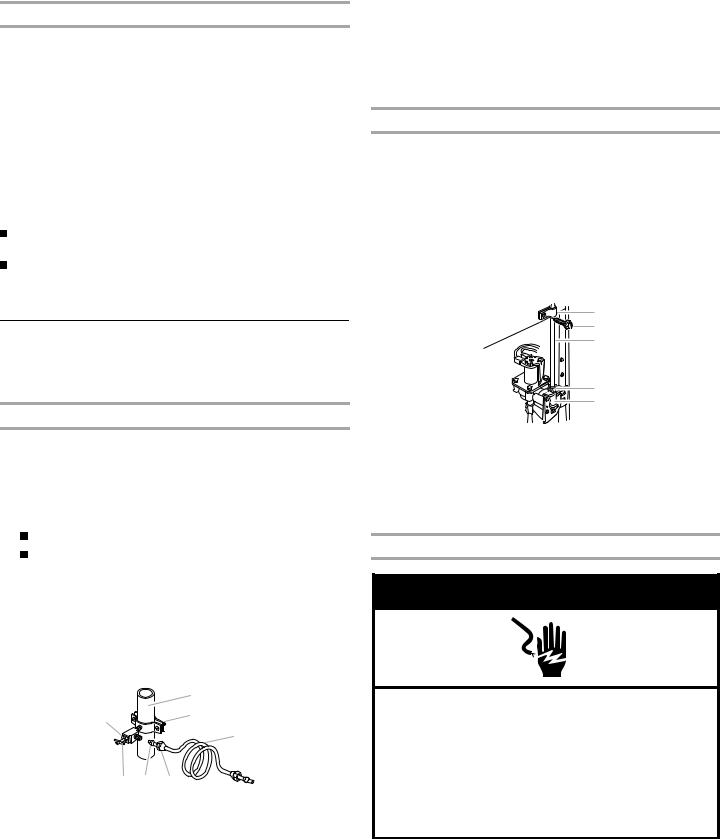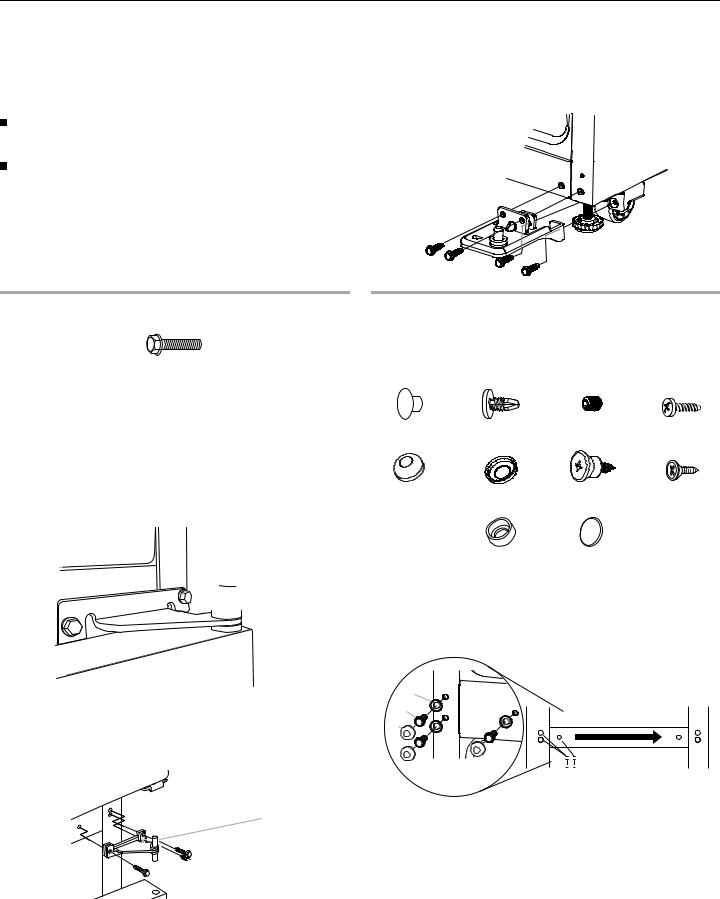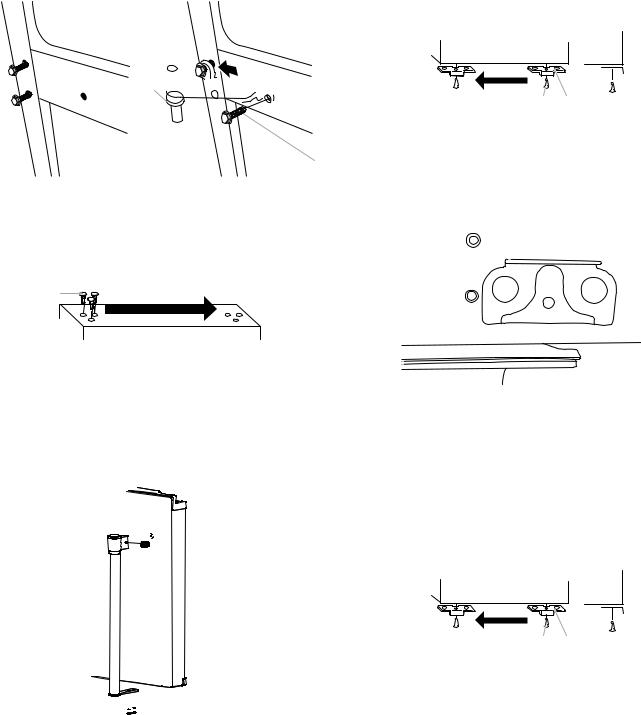Maytag MRT118FFFM01, MRT118FFFZ01, MRT118FFFZ00, MRT118FFFM00, MRT118FFFH01 Owner’s Manual
...
REFRIGERATOR
USER INSTRUCTIONS
THANK YOU for purchasing this high-quality product. Register your new refrigerator at www.maytag.com. In Canada, register your refrigerator at www.maytag.ca.
For future reference, please make a note of your product model and serial numbers. These can be located on the inside wall of the refrigerator compartment.
Model Number ___________________________________________ |
Serial Number____________________________________________ |
Para obtener acceso a “Instrucciones para el usuario del refrigerador” en español, o para obtener información adicional acerca de su producto, visite: www.maytag.com.
Necesitará su número de modelo y de serie, ubicado en el interior del compartimiento del refrigerador.
Table of Contents/Table des matières
REFRIGERATOR SAFETY..................................................................... |
2 |
Proper Disposal of Your Old Refrigerator........................................... |
3 |
INSTALLATION INSTRUCTIONS ......................................................... |
3 |
Unpack the Refrigerator...................................................................... |
3 |
Location Requirements............................................................. |
.......... 4 |
Electrical Requirements ...................................................................... |
4 |
Water Supply Requirements............................................................... |
4 |
Connect the Water Supply............................................................... |
... 5 |
Refrigerator Doors............................................................................... |
6 |
Reversibility Kit Instructions...................................................... |
........11 |
Adjust the Doors ............................................................................... |
11 |
REFRIGERATOR USE ......................................................................... |
12 |
Using the Controls ............................................................................ |
12 |
REFRIGERATOR FEATURES ............................................................. |
13 |
Refrigerator Shelves.................................................................. |
........13 |
Deli Drawer........................................................................................ |
13 |
Crisper............................................................................................... |
13 |
FREEZER FEATURES ......................................................................... |
14 |
Freezer Shelf ............................................................................. |
........14 |
DOOR FEATURES ............................................................................... |
14 |
Door Rails.......................................................................................... |
14 |
Door Bins........................................................................................... |
14 |
Utility Compartment.......................................................................... |
14 |
Ice Maker........................................................................................... |
15 |
REFRIGERATOR CARE....................................................................... |
15 |
Cleaning ............................................................................................ |
15 |
Changing the Light Bulb ................................................................... |
16 |
Vacation and Moving Care ....................................................... |
........16 |
TROUBLESHOOTING.......................................................................... |
17 |
Refrigerator Operation ...................................................................... |
17 |
Temperature and Moisture ............................................................... |
18 |
Ice and Water.................................................................................... |
18 |
ACCESSORIES .................................................................................... |
18 |
WARRANTY.......................................................................................... |
19 |
BRAND BADGE PLACEMENT TEMPLATE................... |
BACK COVER |
SÉCURITÉ DU RÉFRIGÉRATEUR ..................................................... |
|
20 |
Mise au rebut appropriée de votre vieux réfrigérateur..................... |
21 |
|
INSTRUCTIONS D'INSTALLATION ...................... |
............................. |
21 |
Déballage du réfrigérateur ................................................................ |
|
21 |
Exigences d'emplacement ............................................................... |
|
22 |
Spécifications électriques................................................................. |
|
22 |
Spécifications de l’alimentation en eau............................................ |
|
23 |
Raccordement de la canalisation d'eau........................................... |
|
23 |
Portes du réfrigérateur...................................................................... |
|
24 |
Instructions pour l'ensemble d’inversion du sens d’ouverture........ |
30 |
|
Ajustement des portes...................................................................... |
|
30 |
UTILISATION DU RÉFRIGÉRATEUR................................................. |
|
31 |
Utilisation des commandes .............................................................. |
|
31 |
CARACTÉRISTIQUES DU RÉFRIGÉRATEUR .................................. |
32 |
|
Tablettes du réfrigérateur ................................................................. |
|
32 |
Tiroir pour spécialités alimentaires................................................... |
|
32 |
Bac à légumes .................................................................................. |
|
32 |
CARACTÉRISTIQUES DU CONGÉLATEUR...................................... |
33 |
|
Tablette du congélateur.................................................................... |
|
33 |
CARACTÉRISTIQUES DE LA PORTE................................................ |
|
33 |
Tringles de porte............................................................................... |
|
33 |
Balconnets de porte ......................................................................... |
|
34 |
Compartiment utilitaire ..................................................................... |
|
34 |
Machine à glaçons............................................................................ |
|
34 |
ENTRETIEN DU RÉFRIGÉRATEUR ............... |
.................................... |
35 |
Nettoyage.......................................................................................... |
|
35 |
Remplacement des ampoules d’éclairage....................................... |
|
35 |
Entretien avant les vacances ou lors d’un déménagement ............. |
36 |
|
DÉPANNAGE........................................................................................ |
|
37 |
Fonctionnement du réfrigérateur.................................................. |
.... |
37 |
Température et humidité .................................................................. |
|
38 |
Glaçons et eau............................................................ |
...................... |
38 |
ACCESSOIRES .................................................................................... |
|
39 |
GARANTIE............................................................................................ |
|
40 |
GABARIT DE POSITIONNEMENT |
|
|
DE L’INSIGNE DE LA MARQUE.................. |
COUVERTURE ARRIÈRE |
|
W10885251B

REFRIGERATOR SAFETY
Your safety and the safety of others are very important.
many important safety messages in this manual and on your appliance. Always read and obey all safety
safety alert symbol.
alerts you to potential hazards that can kill or hurt you and others.
messages will follow the safety alert symbol and either the word “DANGER” or “WARNING.” mean:
 DANGER
DANGER  WARNING
WARNING
You can be killed or seriously injured if you don't immediately follow instructions.
You can be killed or seriously injured if you don't follow instructions.
All safety messages will tell you what the potential hazard is, tell you how to reduce the chance of injury, and tell you what can happen if the instructions are not followed.
IMPORTANTSAFETYINSTRUCTIONS
WARNING: To reduce the risk of fire, electric shock, or injury when using your refrigerator, follow these basic precautions:
■Plug into a grounded 3 prong outlet.
■Do not remove ground prong.
■Do not use an adapter.
■Do not use an extension cord.
■Disconnect power before servicing.
■Replace all parts and panels before operating.
■Remove doors from your old refrigerator.
■Connect to a potable water supply only.
■Use nonflammable cleaner.
■Keep flammable materials and vapors, such as gasoline, away from refrigerator.
■Use two or more people to move and install refrigerator.
■Disconnect power before installing ice maker (on ice maker kit ready models only).
■Use a sturdy glass when dispensing ice (on some models).
■Do not hit the refrigerator glass doors (on some models).
■This appliance is not intended for use by persons (including children) with reduced physical, sensory or mental capabilities, or lack of experience and knowledge, unless they have been given supervision or instruction concerning use of the appliance by a person responsible for their safety.
■Children should be supervised to ensure that they do not play with the appliance.
SAVETHESEINSTRUCTIONS
State of California Proposition 65 Warnings:
WARNING: This product contains one or more chemicals known to the State of California to cause cancer.
WARNING: This product contains one or more chemicals known to the State of California to cause birth defects or other reproductive harm.
2

Proper Disposal of Your Old Refrigerator
 WARNING
WARNING
Suffocation Hazard Remove doors from your old refrigerator.
Failure to do so can result in death or brain damage.
IMPORTANT: Child entrapment and suffocation are not problems of the past. Junked or abandoned refrigerators are still dangerous
– even if they will sit for “just a few days.” If you are getting rid of your old refrigerator, please follow these instructions to help prevent accidents.
Before You Throw Away Your Old Refrigerator or Freezer:
Take off the doors.
Leave the shelves in place so that children may not easily climb inside.
Important information to know about disposal of refrigerants:
Dispose of refrigerator in accordance with Federal and Local regulations. Refrigerants must be evacuated by a licensed, EPA certified refrigerant technician in accordance with established procedures.
INSTALLATION INSTRUCTIONS
Unpack the Refrigerator
 WARNING
WARNING
Excessive Weight Hazard
Use two or more people to move and install refrigerator.
Failure to do so can result in back or other injury.
Remove the Packaging
When Moving Your Refrigerator:
Your refrigerator is heavy. When moving the refrigerator for cleaning or service, be sure to cover the floor with cardboard or hardboard to avoid floor damage. Always pull the refrigerator straight out when moving it. Do not wiggle or “walk” the refrigerator when trying to move it, as floor damage could occur.
Clean Before Using
IMPORTANT: Do not remove the white foam air return insert from behind the control panel on the ceiling of the refrigerator. If the insert is removed, ice may migrate down from the freezer and cause icicles to form.
Remove tape and glue residue from surfaces before turning on the refrigerator. Rub a small amount of liquid dish soap over the adhesive with your fingers. Rinse with warm water and dry with a soft cloth.
Do not use sharp instruments, rubbing alcohol, flammable fluids, or abrasive cleaners to remove tape or glue. These products can damage the surface of your refrigerator. For more information see, “Refrigerator Safety.”
After you remove all of the package materials, clean the inside of your refrigerator before using it. See the cleaning instructions in “Refrigerator Care.”
Important information to know about glass shelves and covers:
Do not clean glass shelves or covers with warm water when they are cold. Shelves and covers may break if exposed to sudden temperature changes or impact, such as bumping. Tempered glass is designed to shatter into many small, pebble-size pieces. This is normal. Glass shelves and covers are heavy. Use both hands when removing them to avoid dropping.
3

Location Requirements
 WARNING
WARNING
Explosion Hazard
Keep flammable materials and vapors, such as gasoline, away from refrigerator.
Failure to do so can result in death, explosion, or fire.
IMPORTANT: This refrigerator is designed for indoor household use only.
To ensure proper ventilation for your refrigerator, allow for ½" (1.25 cm) of space on each side and at the top. Allow for 1" (2.54 cm) of space behind the refrigerator. If your refrigerator has an ice maker, allow extra space at the back for the water line connections. When installing your refrigerator next to a fixed wall, leave a 2" (5.08 cm) minimum space on the hinge side (some models require more) to allow the door to swing open.
NOTE: This refrigerator is intended for use in a location where the temperature ranges from a minimum of 55°F (13°C) to a maximum of 110°F (43°C). The preferred room temperature range for optimum performance, which reduces electricity usage and provides superior cooling, is between 60°F (15°C) and 90°F (32°C). It is recommended that you do not install the refrigerator near a heat source, such as an oven or radiator.
1/2" (1.25 cm)
2" (5.08 cm)
Electrical Requirements
 WARNING
WARNING
Electrical Shock Hazard Plug into a grounded 3 prong outlet. Do not remove ground prong.
Do not use an adapter.
Do not use an extension cord.
Failure to follow these instructions can result in death, fire, or electrical shock.
Before you move your refrigerator into its final location, it is important to make sure you have the proper electrical connection.
Recommended Grounding Method
A 115-volt, 60 Hz, AC-only, 15or 20-amp fused, grounded electrical supply is required. It is recommended that a separate circuit serving only your refrigerator be provided. Use an outlet that cannot be turned off by a switch. Do not use an
extension cord.
NOTE: Before performing any type of installation, cleaning, or removing a light bulb, turn cooling off or turn the control
(Thermostat, Refrigerator, or Freezer control depending on the model) to OFF, and then disconnect the refrigerator from the electrical source. When you are finished, reconnect the refrigerator to the electrical source and turn cooling on or reset the control (Thermostat, Refrigerator, or Freezer control depending on the model) to the desired setting. See “Using the Controls” in the User Instructions, User Guide, or Use & Care Guide.
Water Supply Requirements
Gather the required tools and parts before starting installation. Read and follow the instructions provided with any tools listed here.
TOOLS NEEDED:
|
Flat-blade screwdriver |
|
¹⁄ " nut driver |
|
|
||
|
|
||
|
⁄ " and ¹⁄ " open-end or two |
|
¹⁄ " drill bit |
|
|
||
|
|
||
|
adjustable wrenches |
|
Cordless drill |
NOTE: Your refrigerator dealer has a kit available with a ¹⁄ "
(6.35 mm) saddle-type shut-off valve, a union, and copper tubing. Before purchasing, make sure a saddle-type valve complies with your local plumbing codes. Do not use a piercing-type or ³⁄ " (4.76 mm) saddle valve which reduces water flow and clogs more easily.
IMPORTANT:
All installations must meet local plumbing code requirements.
Use copper tubing and check for leaks. Install copper tubing only in areas where the household temperatures will remain above freezing.
4

Water Pressure
A cold water supply with water pressure of between 30 and 120 psi (207 and 827 kPa) is required to operate the water
dispenser and ice maker. If you have questions about your water pressure, call a licensed, qualified plumber.
Reverse Osmosis Water Supply
IMPORTANT: The pressure of the water supply coming out of a reverse osmosis system going to the water inlet valve of the refrigerator needs to be between 30 and 120 psi (207 and
827 kPa).
If a reverse osmosis water filtration system is connected to your cold water supply, the water pressure to the reverse osmosis system needs to be a minimum of 40 to 60 psi (276 to 414 kPa).
If the water pressure to the reverse osmosis system is less than 40 to 60 psi (276 to 414 kPa):
Check to see whether the sediment filter in the reverse osmosis system is blocked. Replace the filter if necessary.
Allow the storage tank on the reverse osmosis system to refill after heavy usage.
If you have questions about your water pressure, call a licensed, qualified plumber.
Connect the Water Supply
Read all directions before you begin.
IMPORTANT: If you turn the refrigerator on before the water line is connected, turn the ice maker off.
Connect to Water Line
1.Unplug refrigerator or disconnect power.
2.Turn off main water supply. Turn on nearest faucet long enough to clear line of water.
3.Locate a ½" to 1¹⁄ " (1.25 cm to 3.18 cm) vertical cold water pipe near the refrigerator.
IMPORTANT:
Make sure it is a cold water pipe.
Horizontal pipe will work, but drill on the top side of the pipe, not the bottom. This will help keep water away from the drill and normal sediment from collecting in the valve.
4.Determine the length of copper tubing you need. Measure from the connection on the lower-left rear of refrigerator to the water pipe. Add 7 ft (2.1 m) to allow for cleaning. Use ¹⁄ " (6.35 mm) O.D. (outside diameter) copper tubing. Be sure both ends of copper tubing are cut square.
5.Using a cordless drill, drill a ¹⁄ " hole in the cold water pipe you have selected.
|
A |
G |
B |
|
|
|
C |
F E |
D |
A. Cold water pipe |
E. Compression sleeve |
B. Pipe clamp |
F. Shut-off valve |
C. Copper tubing |
G. Packing nut |
D.Compression nut
6.Fasten the shut-off valve to the cold water pipe with the pipe clamp. Be sure the outlet end is solidly in the ¹⁄ " drilled hole in the water pipe and that the washer is under the pipe clamp.
Tighten the packing nut. Tighten the pipe clamp screws slowly and evenly so washer makes a watertight seal. Do not overtighten or you may crush the copper tubing.
7.Slip the compression sleeve and compression nut on the copper tubing as shown. Insert the end of the tubing into the outlet end squarely as far as it will go. Screw compression nut onto outlet end with adjustable wrench. Do not overtighten.
8.Place the free end of the tubing in a container or sink and turn on the main water supply. Flush the tubing until water is clear. Turn off the shut-off valve on the water pipe. Coil the copper tubing.
Connect to Refrigerator
1.Unplug refrigerator or disconnect power.
2.Attach the copper tubing to the valve inlet using a compression nut and sleeve as shown. Tighten the compression nut. Do not overtighten.
3.Use the tube clamp on the back of the refrigerator to secure the tubing to the refrigerator as shown. This will help avoid damage to the tubing when the refrigerator is pushed back against the wall.
4.Turn shut-off valve on.
5.Check for leaks. Tighten any connections (including connections at the valve) or nuts that leak.
|
A |
|
B |
|
C |
|
D |
|
E |
A. Tube clamp |
D. Compression nut |
B. Tube clamp screw |
E. Valve inlet |
C.Copper tubing
6.The ice maker is equipped with a built-in water strainer. If your water conditions require a second water strainer, install it in the ¹⁄ " (6.35 mm) water line at either tube connection. Obtain a water strainer from your nearest appliance dealer.
Complete the Installation
 WARNING
WARNING
Electrical Shock Hazard Plug into a grounded 3 prong outlet. Do not remove ground prong.
Do not use an adapter.
Do not use an extension cord.
Failure to follow these instructions can result in death, fire, or electrical shock.
1. Plug into a grounded 3 prong outlet.
NOTE: Allow 24 hours to produce the first batch of ice. Discard the first three batches of ice produced. Allow 3 days to completely fill ice container.
5

Refrigerator Doors
Depending on the width of your doorway, you may need to remove the doors to move the refrigerator into your home. Also, the door hinges are factory installed on the right-hand side. If you want the door to open from the other direction, you must reverse the door swing.
IMPORTANT:
Before you begin, turn the refrigerator control off, unplug refrigerator or disconnect power. Remove food and any adjustable door or utility bins from doors.
Depending on your model, your refrigerator has either
Style 1 – Contour Doors or Style 2 – Standard Doors. Reference the graphic specific to your model later in this section
following “Final Steps.”
NOTE: A Reversibility Kit, which includes a new Brand Badge and hole covers, is available.
Tools Needed: ⁄" hex-head socket wrench, #2 phillips screwdriver, flat-blade screwdriver, ⁄" open-end wrench, f lat 2" putty knife
6.Remove the washer from the bottom of the center hinge pin.
7.Lift the refrigerator door from the bottom hinge and set aside.
8.Using a hex-head socket wrench, remove the four ⁄" hex-head hinge screws from the bottom hinge and pull the hinge from the bottom of the refrigerator door.
Remove Doors and Hinges |
|
Reverse Doors and Hinges (optional) |
|
|
|
⁄" Hex-head Hinge Screw
1.Unplug refrigerator or disconnect power.
2.Using a hex-head socket wrench, remove the three ⁄" hex-head hinge screws from the top hinge and lift up to remove the hinge. See Top Hinge graphic.
NOTE: Provide additional support for the doors while the hinges are being moved. Do not depend on the door magnets to hold the doors in place while you are working.
3.Lift the freezer door off of the center hinge and set it aside.
4.Remove the washer from the top of the center hinge pin.
 A
A
A.Washer
5.Using a hex-head socket wrench and an open-end wrench, remove the three screws from the center hinge and remove the hinge. Set aside.
A


 B
B
A.Center hinge
B.⁄" hex-head hinge screws
IMPORTANT: If you want to reverse your doors so that they open in the opposite direction, follow these steps. If you are not reversing the doors, see “Replace Doors and Hinges.”
See complete graphics later in these instructions.
Door Hinge |
Cabinet Hinge |
Setscrew |
Door Stop |
Hole Plug |
Hole Plug |
|
Screw |
Dome Cap |
Dome Cap |
Shoulder |
Flat-Head |
|
Washer |
Screw |
Handle |
|
|
|
Screw |
|
Shoulder |
Door Handle |
|
|
Screw Washer |
Hole Cap |
|
Reverse Center Hinge
1.Remove the three dome caps and screws from the handle side and use them to fill the holes created when the hinge screws were removed.
A
B
C
A. Dome cap washers |
C. Dome caps |
B.Hex-head hinge screws
2.Using the three ⁄" hex-head hinge screws, removed in Step 1, insert two screws halfway into the holes, leaving space to insert the center hinge.
3.Once the refrigerator door is in place, slide the center hinge from the right onto the screws, insert the third screw, and then tighten all screws completely.
6

NOTE: Make sure the washers are in place on both the top and bottom pins of the center hinge.
A  B
B 


A
A.⁄" Hex-head hinge screws
B.Washers
Reverse Freezer Door
1.Remove the three cabinet hole plugs from the top of the cabinet and place them in the hinge holes on the opposite side.
A
A.Cabinet hole plugs
2.Remove the door handles.
■Remove the two flat-head handle screws from the bottom of the freezer door handle.
■Using the ¹⁄" hex key, loosen the setscrew attaching the top of the handle.
■Pull the handle away from the door to release it from the shoulder screw. Keep all parts together.


 A
A



 B
B



 C
C
A. Shoulder screw |
C. Flat-head handle screws |
B.Setscrew
3.Using the plastic tool (provided), remove the brand badge from the freezer door by prying up the right-hand side and slowly peeling the badge away from the door, revealing the hole to mount the door handle.
NOTES:
■To avoid scratching the finish, do not use a sharp or metallic object to pry the brand badge from the door.
■Rub a small amount of liquid dish soap over any adhesive residue with your fingers. Rinse the door with warm water and dry with a soft cloth.
4.Remove the shoulder screw and its washer from the left-hand side of the door and fasten it in to the hole that was behind the brand badge.
5.Remove the door stop from the bottom of the freezer door.
A B
A.Door stop screw
B.Door stop
6.Move the door stop to the opposite side, making sure that the hole in the door stop plate is al igned perfectly with the hole for the center hinge pin.
7.Using the screw removed earlier, fasten the door stop to the bottom of the freezer door.
 A
A
A.Door stop screw
8.Place the handle on the shoulder screw and push the handle toward the door until the mounting base is flush against the door.
9.Fasten the bottom of the handle to the bottom of the freezer door.
10.Tighten all screws. Set aside the freezer door until the hinges and refrigerator door are in place.
Reverse Refrigerator Door
1.Remove the door stop from the bottom of the refrigerator door.
A B
A.Door stop screw
B.Door stop
2.Replace the door stop on the opposite side of the refrigerator door, making sure that the hole in the door stop plate is aligned perfectly with the hole for the bottom hinge pin.
3.Fasten the door stop to the door.
4.Remove the door handles.
■Remove the screws from the top of the refrigerator door handle.
■Remove the setscrew from the lower part of the handle.
■Pull the handle away from the door to release it from the shoulder screw. Keep all parts together.
7
